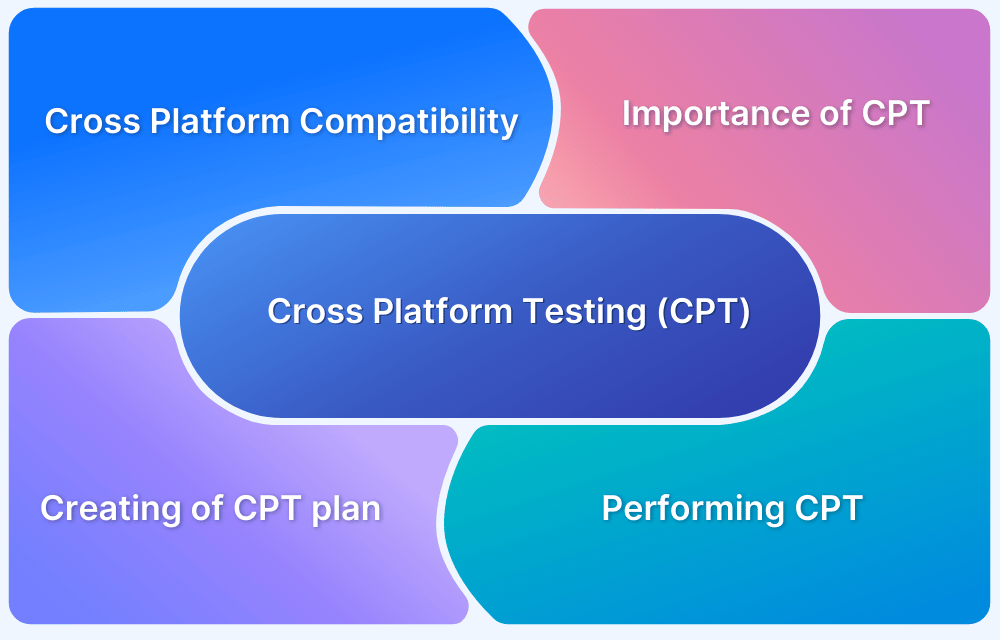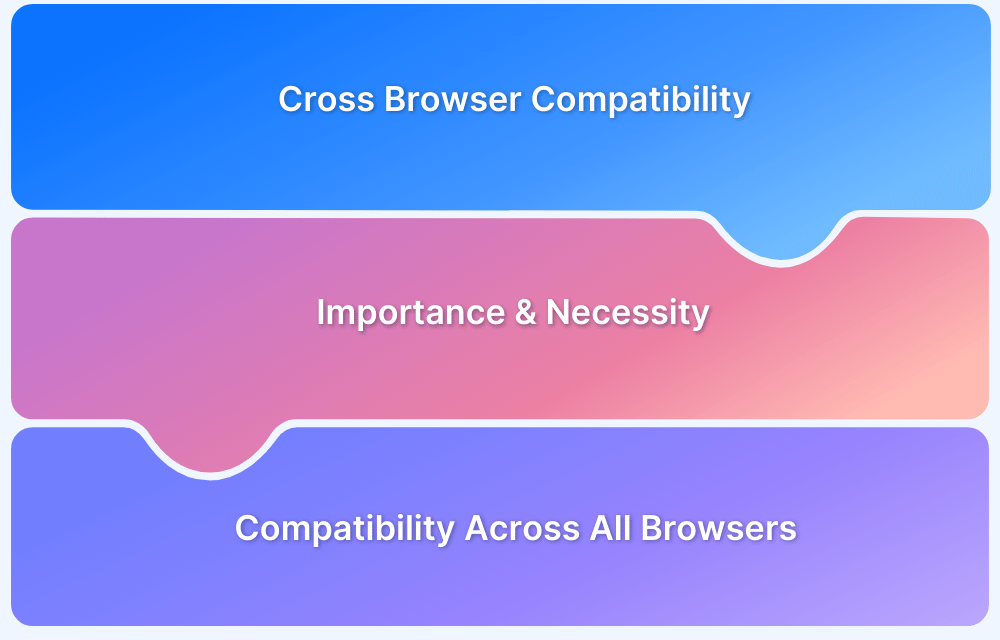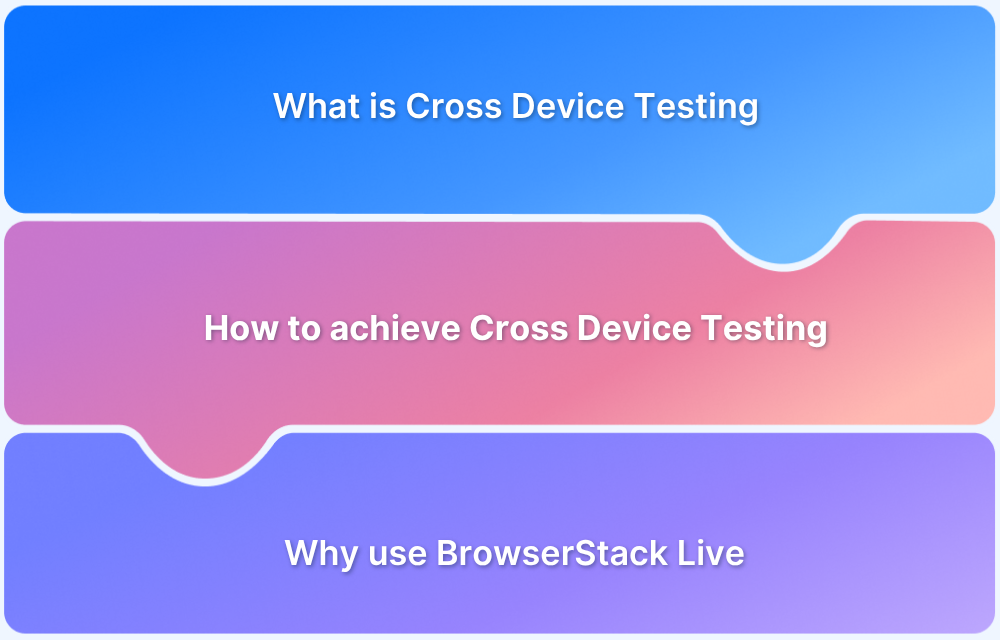Ever noticed how a feature works perfectly on your Mac but fails when someone tries it on Android or Windows? That’s the reality of cross-platform testing. Every browser and device behaves a little differently, and small differences can break critical user journeys.
Cross-platform test automation helps teams catch those issues early. It runs the same tests across browsers, devices, and operating systems so you know exactly where things fail and why before users find out.
This guide explains what cross-platform test automation is, why it matters, which tools help, and how to scale and maintain your setup using real devices for accurate results.
What is Cross-Platform Test Automation?
Cross-platform test automation is the process of writing and executing automated test cases that run across multiple platforms—such as web, mobile, and desktop—without requiring major modifications to the test scripts. Instead of testing separately on different environments, testers leverage frameworks and tools to create reusable scripts that adapt to various operating systems, browsers, and devices.
Key characteristics include:
- Reusability: Write once, execute across different environments.
- Consistency: Ensure that features and workflows behave the same way across platforms.
- Efficiency: Reduce the time and cost of maintaining separate test suites for each platform.
For example, a login test for a shopping app can be automated to run on Android, iOS, Chrome, and Safari using the same script, saving hours of repetitive effort.
Read More: How to perform Cross Device Testing
Why Cross-Platform Automation is Essential?
Cross-platform automation plays a crucial role in modern development lifecycles. Without it, testing efforts become fragmented and inefficient. Some of the most compelling reasons include:
- Ensuring user experience consistency: Customers expect the same app functionality on Android, iOS, Windows, and macOS.
- Reducing release cycles: Automating tests across platforms accelerates delivery, supporting agile and DevOps pipelines.
- Optimizing costs: A single suite of cross-platform tests reduces duplication of effort and infrastructure overhead.
- Improving test coverage: Validates app behavior on a wider range of environments, reducing the risk of production failures.
- Supporting future scalability: As new devices and OS versions emerge, automation frameworks can be extended to cover them without rewriting tests from scratch.
Top Tools for Cross-Platform Test Automation
Selecting the right tools is critical for building effective cross-platform automation. Below are some of the most reliable solutions, along with their overviews and standout features.
1. BrowserStack Automate
BrowserStack Automate is a cloud-based platform that provides instant access to thousands of real browsers and devices for automated cross-platform testing. It eliminates the need to maintain in-house device labs and integrates seamlessly with existing frameworks like Selenium, Appium, Cypress, and Playwright.
Key Features:
- Real device and browser coverage for accurate results
- Parallel test execution to speed up test cycles
- Native integrations with CI/CD pipelines (Jenkins, GitHub Actions, CircleCI)
- Automatic availability of the latest OS and browser versions
- Rich debugging with logs, screenshots, and video recordings
2. Selenium
Selenium is the most widely used open-source framework for cross-browser automation. It supports multiple programming languages and integrates with various CI/CD tools, making it flexible for large-scale testing.
Key Features:
- Automates across Chrome, Firefox, Safari, Edge, and more
- Supports multiple languages (Java, Python, C#, Ruby)
- Large, active community and ecosystem of tools
- Scalable with Selenium Grid for distributed execution
3. Appium
Appium is an open-source automation tool specifically designed for mobile app testing. It supports Android, iOS, and Windows apps with the same API, making it highly reusable across platforms.
Key Features:
- Compatible with native, hybrid, and mobile web applications
- Works with multiple programming languages and test frameworks
- Uses the WebDriver protocol for consistency with Selenium
- Strong support for real device and emulator-based testing
4. Playwright
Playwright, built by Microsoft, is a modern testing framework that supports automation across Chromium, Firefox, and WebKit browsers with one API. It excels in handling modern web app complexities like single-page applications.
Key Features:
- Cross-browser support with a unified API
- Built-in parallelism for faster execution
- Auto-waiting and event-driven architecture reduce test flakiness
- Supports headless and headed browser modes
5. Cypress
Cypress is a JavaScript-based framework ideal for front-end developers testing modern web applications. It runs directly inside the browser, giving developers real-time visibility into test execution.
Key Features:
- Time-travel debugging for easier troubleshooting
- Automatic waiting and retries reduce flaky tests
- Strong developer experience with fast feedback loop
- Native CI/CD integrations and parallelization support
6. TestComplete
TestComplete is a commercial automation tool that supports desktop, web, and mobile testing. It offers both record-and-playback capabilities and scripting, making it suitable for enterprises managing diverse applications.
Key Features:
- Object recognition engine for dynamic UI elements
- Scripted and codeless test creation options
- Supports multiple scripting languages (Python, JavaScript, VBScript)
- Detailed test reporting and analytics
Key Challenges in Cross-Platform Test Automation
While beneficial, cross-platform automation is not without obstacles. Teams must address:
- Device and browser fragmentation: Numerous combinations of devices, browsers, and OS versions make exhaustive testing difficult.
- Test flakiness: Inconsistent execution across environments can lead to false positives or negatives.
- High maintenance: As applications evolve, test scripts may require frequent updates to align with UI changes.
- Integration complexities: Setting up test environments for multiple platforms often involves complicated configurations.
- Performance bottlenecks: Running large test suites across platforms can strain infrastructure if not optimized.
How to Maintain and Scale Cross-Platform Test Automation?
As applications expand and evolve, test suites also grow more complex. Without a structured strategy, cross-platform automation can quickly become unmanageable, leading to longer execution times, higher maintenance costs, and unreliable results. To avoid these pitfalls, teams should adopt the following practices:
- Refactor and optimize regularly: Over time, test suites accumulate redundant or outdated scripts. Periodic reviews help eliminate unnecessary tests, streamline logic, and ensure that scripts remain aligned with the application’s current features.
- Adopt the Page Object Model (POM): By separating the UI structure from test logic, POM reduces duplication and makes updates easier when UI elements change across platforms.
- Use modular and reusable components: Break tests into smaller, independent modules that can be reused across different scenarios and environments. This minimizes duplication and simplifies scaling.
- Leverage parallel execution and distributed testing: Running tests simultaneously across multiple devices, browsers, and OS versions shortens execution times, making scaling more practical.
- Employ AI-driven test maintenance tools: Intelligent locators and self-healing scripts can detect changes in the application UI and update themselves automatically, reducing maintenance overhead.
- Expand environment coverage incrementally: Start by covering the most commonly used devices, browsers, and OS versions, then gradually expand as user analytics dictate. This ensures efficient resource use.
- Track and analyze test metrics: Monitor execution time, flakiness rates, and platform-specific failures. Using data-driven insights helps optimize test suites for long-term scalability.
- Integrate with version control and CI/CD pipelines: Ensuring that test assets are stored in version-controlled repositories and continuously validated in CI/CD workflows allows teams to manage growing suites more effectively.
Best Practices for Effective Cross-Platform Testing
Implementing best practices helps ensure reliable results and scalable test suites.
- Adopt modular test design: Use reusable components to avoid duplication and simplify maintenance.
- Leverage cloud-based testing platforms: Access real devices and browsers on demand without heavy infrastructure costs.
- Prioritize based on usage analytics: Test more rigorously on popular devices, browsers, and OS versions used by your audience.
- Use parallel execution: Run multiple test cases simultaneously to reduce execution time.
- Implement version control for test assets: Track and manage changes to test scripts across distributed teams.
- Automate reporting and monitoring: Generate actionable insights into failures, trends, and platform-specific issues.
Get Expert QA Guidance Today
Schedule a call with BrowserStack QA specialists to discuss your testing challenges, automation strategies, and tool integrations. Gain actionable insights tailored to your projects and ensure faster, more reliable software delivery.
Why Perform Cross-Platform Test Automation on Real Devices?
Testing on emulators and simulators provides value during early development stages, but they cannot fully replicate real-world conditions such as network variability, battery usage, hardware limitations, or OS-specific behaviors.
Running cross-platform tests on real devices ensures:
- Accurate validation of app behavior under real-world conditions.
- Reliable detection of device-specific bugs that simulators often miss.
- Performance benchmarking under actual load and hardware constraints.
This is where BrowserStack Automate plays a crucial role. It provides access to a vast cloud of real browsers and devices, enabling teams to run automated cross-platform tests at scale. With built-in parallel execution, CI/CD integrations, and instant availability of the latest OS/browser versions, BrowserStack eliminates the need for expensive in-house device labs and infrastructure.
Conclusion
Cross-platform test automation is indispensable for ensuring application quality across today’s fragmented device and browser ecosystem.
By selecting the right tools, overcoming challenges, and adopting best practices, organizations can achieve consistent user experiences, faster releases, and reduced costs. Integrating automation into CI/CD pipelines and running tests on real devices through platforms like BrowserStack ensures that applications remain reliable, scalable, and future-ready.







